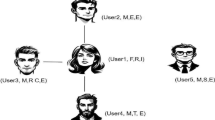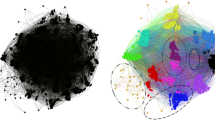Abstract
The most basic and significant issue in complex network analysis is community detection, which is a branch of machine learning. Most current community detection approaches, only consider a network's topology structures, which lose the potential to use node attribute information. In attributed networks, both topological structure and node attributed are important features for community detection. In recent years, the spectral clustering algorithm has received much interest as one of the best performing algorithms in the subcategory of dimensionality reduction. This algorithm applies the eigenvalues of the affinity matrix to map data to low-dimensional space. In the present paper, a new version of the spectral cluster, named Attributed Spectral Clustering (ASC), is applied for attributed graphs that the identified communities have structural cohesiveness and attribute homogeneity. Since the performance of spectral clustering heavily depends on the goodness of the affinity matrix, the ASC algorithm will use the Topological and Attribute Random Walk Affinity Matrix (TARWAM) as a new affinity matrix to calculate the similarity between nodes. TARWAM utilizes the biased random walk to integrate network topology and attribute information. It can improve the similarity degree among the pairs of nodes in the same density region of the attributed network, without the need for parameter tuning. The proposed approach has been compared to other primary and new attributed graph clustering algorithms based on synthetic and real datasets. The experimental results show that the proposed approach is more effective and accurate compared to other state-of-the-art attributed graph clustering techniques.







Similar content being viewed by others
References
Palla, G., et al.: Uncovering the overlapping community structure of complex networks in nature and society. Nature 435(7043), 814–818 (2005)
Wang, X., et al.: Public discourse and social network echo chambers driven by socio-cognitive biases. Phys. Rev. X 10(4), 041042 (2020)
Liu, L., et al.: Homogeneity trend on social networks changes evolutionary advantage in competitive information diffusion. N. J. Phys. 22(1), 013019 (2020)
Fortunato, S.: Community detection in graphs. Phys. Rep. 486(3–5), 75–174 (2010)
Cai, J., et al.: Enhancing network capacity by weakening community structure in scale-free network. Futur. Gener. Comput. Syst. 87, 765–771 (2018)
Berahmand, K., Bouyer, A., Vasighi, M.: Community detection in complex networks by detecting and expanding core nodes through extended local similarity of nodes. IEEE Trans. Comput. Soc. Syst. 5(4), 1021–1033 (2018)
Newman, M.E.: Spectral methods for community detection and graph partitioning. Phys. Rev. E 88(4), 042822 (2013)
Zhou, L., et al.: An approach for overlapping and hierarchical community detection in social networks based on coalition formation game theory. Expert Syst. Appl. 42(24), 9634–9646 (2015)
Günnemann, S., Boden, B., Seidl, T.: DB-CSC: a density-based approach for subspace clustering in graphs with feature vectors. In: Joint European Conference on Machine Learning and Knowledge Discovery in Databases. Springer, New York (2011)
Chunaev, P.: Community detection in node-attributed social networks: a survey. Comput. Sci. Rev. 37, 100286 (2020)
Bothorel, C., et al.: Clustering attributed graphs: models, measures and methods. Netw. Sci. 3, 408–444 (2015)
Zhou, Y., Cheng, H., Yu, J.X.: Clustering large attributed graphs: an efficient incremental approach. In: 2010 IEEE International Conference on Data Mining. IEEE (2010)
White, S., Smyth, P.: A spectral clustering approach to finding communities in graphs. In: Proceedings of the 2005 SIAM international conference on data mining. SIAM (2005)
Zhang, S., Wang, R.-S., Zhang, X.-S.: Identification of overlapping community structure in complex networks using fuzzy c-means clustering. Physica A 374(1), 483–490 (2007)
Peng, R., Sun, H., Zanetti, L.: Partitioning well-clustered graphs: spectral clustering works! In: Conference on learning theory. PMLR (2015)
Nascimento, M.C., De Carvalho, A.C.: Spectral methods for graph clustering–a survey. Eur. J. Oper. Res. 211(2), 221–231 (2011)
Zhang, Z., Jordan, M.I.: Multiway spectral clustering: a margin-based perspective. Stat. Sci. 23(3), 383–403 (2008)
Zass, R., Shashua, A.: A unifying approach to hard and probabilistic clustering. In: Tenth IEEE International Conference on Computer Vision (ICCV'05) vol. 1. IEEE (2005)
Xia, T., et al.: On defining affinity graph for spectral clustering through ranking on manifolds. Neurocomputing 72(13–15), 3203–3211 (2009)
Chauhan, S., Girvan, M., Ott, E.: Spectral properties of networks with community structure. Phys. Rev. E 80(5), 056114 (2009)
Arenas, A., Diaz-Guilera, A., Pérez-Vicente, C.J.: Synchronization reveals topological scales in complex networks. Phys. Rev. Lett. 96(11), 114102 (2006)
Cheng, X.-Q., Shen, H.-W.: Uncovering the community structure associated with the diffusion dynamics on networks. J. Stat. Mech. Theory Exp. 2010(04), P04024 (2010)
Newman, M.E.: Modularity and community structure in networks. Proc. Natl. Acad. Sci. 103(23), 8577–8582 (2006)
Shen, H.-W., Cheng, X.-Q., Fang, B.-X.: Covariance, correlation matrix, and the multiscale community structure of networks. Phys. Rev. E 82(1), 016114 (2010)
Zhang, X., You, Q.: An improved spectral clustering algorithm based on random walk. Frontiers of Computer Science in China 5(3), 268 (2011)
Ren, S., Zhang, S., Wu, T.: An improved spectral clustering community detection algorithm based on probability matrix. Discret. Dyn. Nat. Soc. 8, 1–6 (2020)
Hu, F., et al.: Community detection in complex networks using Node2vec with spectral clustering. Physica A 545, 123633 (2020)
Wang, Z., et al., A community detection algorithm based on topology potential and spectral clustering. Sci. World J. (2014). https://doi.org/10.1155/2014/329325
Mahmood, A., Small, M.: Subspace based network community detection using sparse linear coding. IEEE Trans. Knowl. Data Eng. 28(3), 801–812 (2015)
Steinhaeuser, K., Chawla, N.V.: Identifying and evaluating community structure in complex networks. Pattern Recogn. Lett. 31(5), 413–421 (2010)
Nawaz, W., et al.: Intra graph clustering using collaborative similarity measure. Distrib. Parallel Datab. 33(4), 583–603 (2015)
Zhou, H., et al.: A graph clustering method for community detection in complex networks. Physica A 469, 551–562 (2017)
Agrawal, S., Patel, A.: SAG Cluster: An unsupervised graph clustering based on collaborative similarity for community detection in complex networks. Physica A 563, 125459 (2021)
Ayoub, R.: Euler and the zeta function. Am. Math. Mon. 81(10), 1067–1086 (1974)
Li, W., Jiang, S., Jin, Q.: Overlap community detection using spectral algorithm based on node convergence degree. Futur. Gener. Comput. Syst. 79, 408–416 (2018)
Alinezhad, E., et al.: Community detection in attributed networks considering both structural and attribute similarities: two mathematical programming approaches. Neural Comput. Appl. 32(8), 3203–3220 (2020)
Zhou, Y., Cheng, H., Yu, J.X.: Graph clustering based on structural/attribute similarities. Proc. VLDB Endow. 2(1), 718–729 (2009)
Meng, F., et al.: Coupled node similarity learning for community detection in attributed networks. Entropy 20(6), 471 (2018)
Jia, C., et al.: Node attribute-enhanced community detection in complex networks. Sci. Rep. 7(1), 1–15 (2017)
Pizzuti, C., Socievole, A.: A genetic algorithm for community detection in attributed graphs. In: International Conference on the Applications of Evolutionary Computation. Springer (2018)
Berahmand, K., et al., A new attributed graph clustering by using label propagation in complex networks. J. King Saud Univ. Comput. Inf. Sci. (2020). https://doi.org/10.1016/j.jksuci.2020.08.013
Cheng, H., et al.: Clustering large attributed information networks: an efficient incremental computing approach. Data Min. Knowl. Disc. 25(3), 450–477 (2012)
Huang, X., Cheng, H., Yu, J.X.: Dense community detection in multi-valued attributed networks. Inf. Sci. 314, 77–99 (2015)
Gao, H., Huang, H.: Deep attributed network embedding. In: Twenty-Seventh International Joint Conference on Artificial Intelligence (IJCAI) (2018)
Cao, S., Lu, W., Xu, Q.: Grarep: learning graph representations with global structural information. In: Proceedings of the 24th ACM International on Conference on Information and Knowledge Management (2015)
Tang, J., et al.: Line: Large-scale information network embedding. In Proceedings of the 24th International Conference on World Wide Web (2015)
Le, T.M., Lauw, H.W.: Probabilistic latent document network embedding. In: 2014 IEEE International Conference on Data Mining. IEEE (2014)
Zhang, Z., et al.: ANRL: attributed network representation learning via deep neural networks. In: IJCAI (2018)
Wang, C., et al.: Attributed graph clustering: a deep attentional embedding approach. (2019). http://arxiv.org/abs/1906.06532
Zhang, X., et al.: Attributed graph clustering via adaptive graph convolution. (2019). http://arxiv.org/abs/1906.01210
Kipf, T.N., Welling, M.: Semi-supervised classification with graph convolutional networks. (2016). http://arxiv.org/abs/1609.02907
Henaff, M., Bruna, J., LeCun, Y.: Deep convolutional networks on graph-structured data. (2015). http://arxiv.org/abs/1506.05163.
Wang, C., et al.: Mgae: marginalized graph autoencoder for graph clustering. In: Proceedings of the 2017 ACM on Conference on Information and Knowledge Management. (2017)
Sun, H., et al.: Network embedding for community detection in attributed networks. ACM Trans. Knowl. Discov. Data (TKDD) 14(3), 1–25 (2020)
Luo, M., Yan, H.: Adaptive attributed network embedding for community detection. In: Chinese Conference on Pattern Recognition and Computer Vision (PRCV). Springer (2020)
Zhou, Z., Amini, A.A.: Analysis of spectral clustering algorithms for community detection: the general bipartite setting. J. Mach. Learn. Res. 20(47), 1–47 (2019)
Gulikers, L., Lelarge, M., Massoulié, L.: A spectral method for community detection in moderately sparse degree-corrected stochastic block models. Adv. Appl. Probab. 49, 686–721 (2017)
Li, Y., et al.: Local spectral clustering for overlapping community detection. ACM Trans. Knowl. Discov. Data (TKDD) 12(2), 1–27 (2018)
Liu, F., et al.: Global spectral clustering in dynamic networks. Proc. Natl. Acad. Sci. 115(5), 927–932 (2018)
Ye, F., et al.: Homophily preserving community detection. IEEE Trans. Neural Netw. Learn. Syst. 31(8), 2903–2915 (2019)
Nasiri, E., Berahmand, K., Li, Y.: A new link prediction in multiplex networks using topologically biased random walks. J. Chaos Solit. Fract. 151, 111230 (2021)
Forouzandeh, S., Rostami, M., Berahmand, K.: Presentation a trust walker for rating prediction in recommender system with biased random walk: effects of H-index centrality, similarity in items and friends. Eng. Appl. Artif. Intell. 104, 104325 (2021)
Berahmand, K., et al., A preference random walk algorithm for link prediction through mutual influence nodes in complex networks. J. King Saud Univ. Comput. Inf. Sci. (2021). https://doi.org/10.1016/j.jksuci.2021.05.006
Liu, W., Lü, L.: Link prediction based on local random walk. EPL (Europhysics Letters) 89(5), 58007 (2010)
Kuncheva, L.I., Hadjitodorov, S.T.: Using diversity in cluster ensembles. In: 2004 IEEE International Conference on Systems, Man and Cybernetics (IEEE Cat. No. 04CH37583). IEEE (2004)
Rand, W.M.: Objective criteria for the evaluation of clustering methods. J. Am. Stat. Assoc. 66(336), 846–850 (1971)
Chen, M., Kuzmin, K., Szymanski, B.K.: Community detection via maximization of modularity and its variants. IEEE Trans. Comput. Soc. Syst. 1(1), 46–65 (2014)
Pizzuti, C., Socievole, A.: Multiobjective optimization and local merge for clustering attributed graphs. IEEE Trans. Cybernet. 50(12), 4997–5009 (2019)
Lancichinetti, A., Fortunato, S., Radicchi, F.: Benchmark graphs for testing community detection algorithms. Phys. Rev. E 78(4), 046110 (2008)
Author information
Authors and Affiliations
Corresponding author
Additional information
Publisher's Note
Springer Nature remains neutral with regard to jurisdictional claims in published maps and institutional affiliations.
Rights and permissions
About this article
Cite this article
Berahmand, K., Mohammadi, M., Faroughi, A. et al. A novel method of spectral clustering in attributed networks by constructing parameter-free affinity matrix. Cluster Comput 25, 869–888 (2022). https://doi.org/10.1007/s10586-021-03430-0
Received:
Revised:
Accepted:
Published:
Issue Date:
DOI: https://doi.org/10.1007/s10586-021-03430-0




